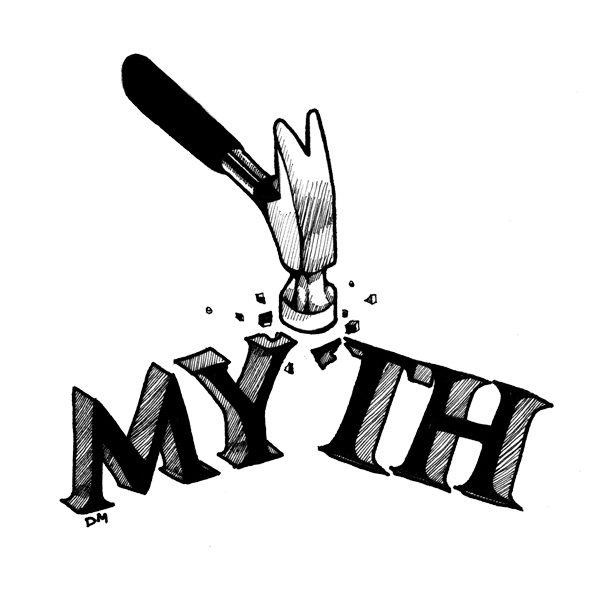 Easter is upon us and Spring has sprung in most parts of the US and winter has essentially made its mark for this year. I often forget about the snow and the fun I had in it when I was young and the mess it just seems to be for a lot of us as we get older.
Easter is upon us and Spring has sprung in most parts of the US and winter has essentially made its mark for this year. I often forget about the snow and the fun I had in it when I was young and the mess it just seems to be for a lot of us as we get older.
One myth I would like to dispel is that in South America where I live (part of the year) it is not all jungle with all that entails including hot humid weather. I happen to be just under eight thousand feet up in the mountains where the windows are left open year round and it is always comfortable. South America encompasses just about every type of climate and where I’m at almost all are all just a short drive or flight away.
And as the saying goes time flies by and in business it is no different so I will get to the point. Sometimes we get caught up in a mindset that does not allow us to keep up with the pace of change which is how myths get created and at least in this context we can define here as beliefs without determinable basis of fact.
The following slide show fast forwards you to some of today’s realities of what has changed in B2B marketing you may not be aware of or caught up to yet. The study this slide show is based on was posted in an article in Google’s Think Newsletter and written by Kelsey Snyder and Pashmeena Hilal. It was done by Google in partnership with Millward Brown Digital and brings us back to reality with what has changed in B2B marketing.
They surveyed approximately 3,000 B2B researchers about their research and purchase habits as well as their use of digital (specifically, search, mobile, and video). Then Google analyzed 13 months of clickstream data from Millward Brown Digital's desktop panel.
The study which was done in 2014 mirroring research done in 2012, gives you insights into the changes over the past couple of years. The results lay to rest some widely held beliefs that will potentially have a big impact on your B2B marketing strategies.
Â
![The Science of B2B Online Marketing [INFOGRAPHIC]](http://www.circlesstudio.com/blog/wp-content/uploads/2014/01/the-science-of-b2b-online-marketing-infographic-circle-s-studio.jpg)
Reposted from CoxBlue.com
70% follow social media for business purposes-Can it be ingnored?
Tags:
 70% social media visitors are frequenting platforms for business purposes which surely wants to make B2B marketers to want to sit up and take note.
70% social media visitors are frequenting platforms for business purposes which surely wants to make B2B marketers to want to sit up and take note.
Lets start by understanding a few quick facts about B2B social media marketing
- Organisations set varied goals on social media which in descending order range from brand awareness, customer acquisition lead generation to customer retention.
- B2B marketers rate blogs & in person events as most effective
- After Twitter and Linkedin, Youtube and slideshare has been rated as second most effective marketing form for B2B content.
- On an average 30% of B2B marketing budgets are allocated to content marketing. Needs to be provision for in all B2b marketing plans without which no amount of promotion will deliver results.
- Most content of B2B marketing are based on industry trends.
- Metrics of success vary from reach, downloads, lead generation to brand sentiment positive versus negative.
- Twitter dominates the B2B landscape whilst in terms of efficacy of content the blog scores the highest.
- The top preferred social media channels for marketers include twitter, linkedin, Youtube, facebook and the blog
Platform choices should be decided based on nature of content to maximise conversation value and virality. Serious brand centric content is best placed on blogs, twitter, linkedin etc whilst casual customer centric content thrives on facebook/youtube etc. Also blogs become ideal for thought leadership, linkedin for collaboration and twitter for marketing services.

Today B2B marketers are using various techniques to harness interaction levels on platforms and increase frequency of visitation. Eg : Cisco runs a UGC (User generated consumer) blog and rewards visitors, contributors, active writers, employees who contribute to it in the form of badges and a meter which is trackable using Cisco logins. The same is visible in the screens below.

Dell also runs a rewards programme on facebook to encourage repeat visitation, engagement and conversations . To strengthen its social media presence it has also set up a social media listening center powered by listening tools. The dashboard ensures realtime responses and feedback along with an always on sense of positive /negative sentiments.

You tube being another very critical b2b channels content investments are being made to build a rich repository of videos ranging from product ,service, customer support, events and specials. Cisco being a classic example of building a video enabled site on youtube.

B2B brands are recognizing the importance of being conversational and casual to connect better. Hence posts which spark conversations are becoming critical.
“ Wish you could indulge in multi-tasking/face to face interaction even in the cloud? What if you could attend a board meeting at the Headquarters without moving
an inch from your cubicle?â€
The key mantra to good content marketing on social media is to build a rich content property/platform and circulate/ interlink it across social media touchpoints in various formats to multiply reach, virality and conversations to amplify it. The same in turn enables buzz, multiple inbound links, better searchability and scale.

This is a far better strategy versus fragmenting content, creating multiple content inputs and spreading the investments thin. Also to create consumable content for B2B marketing its
critical to build it in the form of downloadables, videos, infographics and articles.

Social media success metrics should always be mapped against set objectives which can range from reach within the TG to increasing website traffic or lead generation to influence.. The measures vary based on platform . Eg : Views on youtube, followers on Twitter/Linkedin, fans on Facebook , Mentions/retweets /PTAT .

B2B marketers need to adopt the following approach to build robust social media presence .
• Listen – don’t pitch
• Entertain – make people laugh
• Educate – Share helpful information
• Listen some more
• Ask questions – solicit feedback/market research
• Be transparent, reciprocative and accountable to the community
Whilst we take cues from B2B marketers like Cisco and Dell who have got their act together and made huge foray in social media the following 7 steps would certainly ensure a kickstart in the right direction.
1. Set social media goals which tie back with overall business goals
2. Allocate minimum of 20% + of social media budgets for content creation
3. Create a content strategy as a first step before venturing into conversations in the community
4. Build a robust content property around the same which rests in a central location preferably on the blog.
5. Have a distribution plan in place to interlink the content property across social platforms and maximise distribution, inbound links
6. Measure success against the goals set
7. Have relative progressive benchmarks to build on social media plans
So its time to gear up to be a truly networked brand and interact, engage, collaborate using available social media platforms & tools.
Sources :B2B Social media brand channels
B2B social media whitepapers
Forrester research
Industry experts POV
Slideshare
Case studies
By Moneka Khurana, Digital Consultant and Trainer
If there’s one message that gets drummed into the heads of every participant on every sales training course, it’s “make sure you’re talking to the decision-makerâ€. At face value, this seems like sound advice. But the reality is often rather more complex.
To start with, the very idea that there is a likely to be a single decision-maker in any high value complex B2B buying process is flawed. Sure, it can still occasionally happen in exceptional circumstances where one powerful individual can impose their will over others (assuming they want to).
The drive for consensus
 However, all the evidence points to increasingly complex B2B buying decision processes. More stakeholders are actively involved than in years gone by and organisations are inclined to drive for consensus and to take an increasingly risk-averse approach to decision-making
However, all the evidence points to increasingly complex B2B buying decision processes. More stakeholders are actively involved than in years gone by and organisations are inclined to drive for consensus and to take an increasingly risk-averse approach to decision-making
There may, in fact, be no one individual that has the power to say “yes†on their own, but there are likely to a significant number of powerful players that have the ability to say “no†or “not nowâ€. This makes a decision to stick with the status quo and do nothing a very common outcome.
The danger of confusing championship with influence
Traditional sales training methodologies suggest that you need to find a Champion or Coach within your prospect that is prepared to provide you with privileged information and help you build your case. But it’s far too easy (and very dangerous) to confuse championship with influence.
It’s critical that you connect with contacts that are willing and able to influence their colleagues on the decision making team, and who are expert at the politics of making change happen within their organisation. You need to find the people who can walk the walk as well as talking the talk.
You need to identify - and identify with - the people who are capable of leading their colleagues on the difficult journey that may be required to make the right decision, to make the decision stick, and to implement the chosen solution despite potential pitfalls.
Mobilising the decision-shapers
This calls for a particular breed of person. Their power does not just come from their position on an organisation chart - their power comes from the respect they have earned from their colleagues as being a “safe pair of handsâ€. They are the people their colleagues turn to for advice.
As the authors of The Challenger Sale pointed out in a recent Harvard Business Review article, these people are mobilisers - and in an uncertain and complex world, if your putative champion isn’t a mobiliser, you had better think again about forecasting that deal with any sort of confidence.
Spotting the mobilisers
So how can you spot these mobilisers? They often reveal themselves in their response to some carefully targeted questions. These questions are, by the way, all predicated on the assumption that you have identified an issue that appears to be important. You might, for example, ask your contact:
-
- What impact is this issue having on the rest of the organisation?
- How has the organisation tried to address the issue before?
- Why is now the right time to deal with the issue?
- What other projects might compete for the same resources?
- What would happen if nothing is done about the issue?
- Who else within the organisation is affected?
- How is the issue affecting them?
- How are decisions like this usually made?
- What was the most recent example? What was the outcome?
- What role did you play in the decision? Who else played a key part? Who did you have to convince?
- What usually makes the difference as to whether projects like this go ahead?
I’ve found that questions like this fairly quickly flush out whether your contact is in command of their brief, whether they understand the impact of the issue, whether they appear to really understand how decisions are made in their organisation, and whether they come across as a true mobiliser.
Mastering the politics
If they can’t - for example - tell you who else is affected and why, and won’t help you gain access to them, or if they appear vague about how decision-making politics get played out in their organisation, you can probably safely assume that you are not talking to a mobiliser (or a decision-maker).
In today’s complex B2B buying environment, narrowly focusing on the decision-maker is a losing strategy. Instead, you need to identify all the decision-shapers across the organisation and understand what’s in it for them. And, rather than a champion, you need to find a mobiliser that can help you reach them all.
Final thought: I recommend you reflect on all your current forecast opportunities. Have you identified and reached all the decision-shapers? And have you got a champion who is acting like a proven mobiliser? If not, I suggest you prepare your excuses for the boss.
Post by: Bob Apollo of Inflexion-Point | @bobapollo | LinkedIn
The Big Data revolution is benefiting marketing leaders the most. It’s transformed numerous aspects of how we work and think. In many ways, the capability is the answers to every marketer’s dreams. When a problem surfaces, the first course of action is to solve it with data insights.
Today, I offer you a guest post from Brian Kardon, CMO at Lattice Engines. Their tools leverage Big Data to help those market & sell intelligently. In this post, he shares how Big Data uncovers key LeadGen insights. Specifically, how Lead Development Reps can close more business by doing less. Brian shows how to fix low lead conversion rates with insights from Big Data.  At the end of this post, download our Big Data Source Checklist. Use this to make sure you are building a world-class data foundation.
The Folly of Persistence by Brian Kardon
Persistent sales people are praised, honored, and even given swanky “President’s Club†trips to the Caribbean. As Gordon Gekko (Michael Douglas) famously said to Bud Fox (Charlie Sheen) in the movie “Wall Streetâ€:
“This is the kid, calls me 59 days in a row, wants to be a player. There ought to be a picture of you in the dictionary under persistence, kid.â€

The rep that calls a prospect 50 times and stalks him on LinkedIn is the very essence of a modern, successful sales person. Right?
An analysis of millions of pieces of data challenges the near universal celebration of persistence. In fact, the data show that quitters, who know when to quit, win in the end.
There is a dearth of data-driven insight about the process of selling. We wanted to apply data science to one of the last bastions of folklore and anecdote – sales. Working with my colleagues Paolo Massimi, Ph.D., and Shashi Upadhyay, Ph.D., we looked at the performance of more than 1,000 sales reps over a thirty month period. The call logs we analyzed had more than four million entries: number of outbound calls, messages left, completed calls, scheduled meetings. We then looked at the actual deals that closed from those efforts. Our hypothesis was that persistence pays off. But the data told a completely different story.
-
Sales reps are simply too persistent. There is a point of diminishing returns after which the conversion rate drops quite dramatically. Reps should call a prospect less than seven times. The effort beyond seven outbound calls, on average, does not correlate with better win rates.
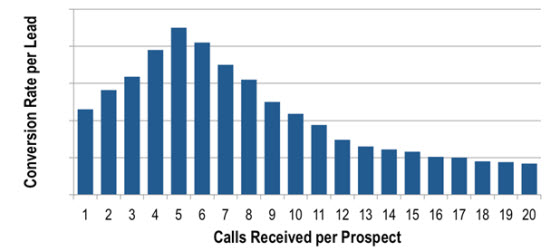
- Sales reps spend too much time with accounts that will never close. 97% of effort is spent with prospects that will never close. Reps should stop calling a prospect after a certain point and focus on their uncalled accounts. If you ask a sales rep what their biggest time-waster is, they will likely say some variety of “administrative tasks†– entering data into the CRM, doing expense reports, booking travel. They hate that stuff! But the real time-waster is time spent with the wrong prospect: one that will never close.
- The best performing reps instinctively know when to quit. In our study, the reps having the highest quota achievement came closest to the “optimal†number of outbound calls. They knew when it was time to move on. Poor performing reps spent too much time trying to connect with accounts with low conversions. The long tail of effort (phone calls beyond the ninth) accounted for 50% of their time.
- The number of days between calls matters. Concentrated calls to a prospect are more effective than spreading calls out over more days. Some reps talk about a “drip call†strategy: they call once a week, or every 2 weeks. Our analysis shows that this is a poor strategy. The best call strategy is a concentrated one – focus calls for multiple days in a row. A fast pour beats a slow drip every time. Bud Fox got it right when he persistently called Gordon Gekko every day. Of course, data science would have advised Bud to stop calling after seven attempts, not fifty nine.
Most sales professionals face the “curse of abundance†every day. There are too many people to call. How do you prioritize? Ironically, reps can close more business by doing less. Sales reps should be “intelligently persistent†by knowing when to stop trying to connect with an account. Companies can help their sales teams by analyzing their own big data to find the right moment to quit. Data science can help figure this out.
For peak sales performance, the true winners are often quitters. To all you quitters out there, see you next year at “President’s Club.â€
Posted by John Koehler on Sales Benchmark Index
Marketers who get inundated with these types of stories get an inflated view of the market penetration of new technologies. But if there is a lot of hot air in these numbers, what can we say about the actual adoption rates of marketing automation software? We delved into this question in our just-published eBook, Marketing Automation: An Industry Overview.
We looked at the total number of businesses in the U.S. but took out the smallest of enterprises – those with not even a single employee. The table below shows marketing automation software use by size of company. Keep in mind there are also over 20 million businesses with zero employees – freelancers, consultants, and other self-employed people, many of whom use email marketing software and could be ripe to upgrade to marketing automation platforms.
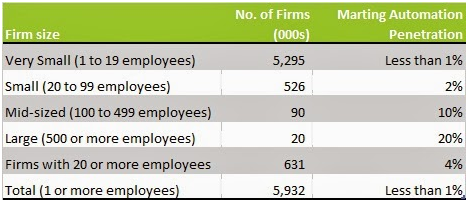
Â
In his book, Crossing the Chasm, Geoffrey A. Moore describes a technology lifecycle in which the adoption or acceptance of a new product or innovation proceeds according to the demographic and psychological characteristics of defined adopter groups. According to Moore’s model, the first group of people to use a new product is called “innovators,†followed by “early adopters.†The “chasm†is the crucial period during which a product is either adopted broadly, or remains part of a niche market (or fails). The “early majority†and “late majority†then adopt the product, followed by the last group,
known as “laggards.â€
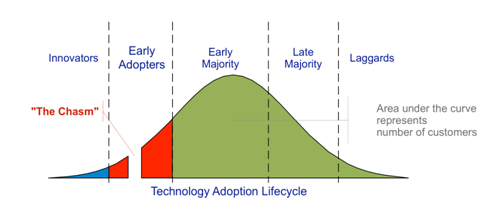
Â
If this model is applied to the marketing automation sector, it becomes evident that, although the technology is still early in its lifecycle, the chasm is indeed being crossed – at least among large companies.
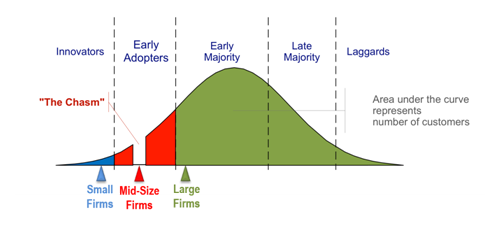
Â
Figure 2 shows that marketing automation among large firms has crossed the chasm and has now reached the Early Majority stage. By contrast, mid-sized firms are just now crossing the chasm while small firms are still in the Innovators stage. This explains the growing number of marketing automation vendors seeking to gain a foothold into this market, as well as the substantial venture capital the sector has attracted.
What’s especially interesting is why companies are spending the time and effort to cross the chasm. Is the payoff worth the risk? You can read about the compelling case for marketing automation, including capabilities and benefits, in our brand-new Marketing Automation: An Industry Overview eBook.
Dan Freeman of Marketing Growth Strategies has over 25 years of senior level management consulting and marketing experience, working with Fortune 100 organizations as well as small and mid-sized businesses. Dan combines hands-on management experience with advanced knowledge of marketing technologies and all aspects of digital marketing in order to help clients find, get, and keep the right customers to grow their top line.
OK, so you’re hearing a lot about marketing automation. Getting tweets and emails and reading blogs and white papers about how it’s simplifying and transforming the lives of marketers. From all this hype, you might have the impression that everyone who’s anyone in marketing is using marketing automation software. I recently saw a headline claiming that 46 percent of B2B companies use marketing automation. When I read the details, it was clear that the 46 percent represented those that responded to a marketing automation survey. Who responds to a marketing automation survey? Usually those that use marketing automation software. Duh! This was not even remotely representative of the marketplace as a whole.
Marketers who get inundated with these types of stories get an inflated view of the market penetration of new technologies. But if there is a lot of hot air in these numbers, what can we say about the actual adoption rates of marketing automation software? We delved into this question in our just-published eBook, Marketing Automation: An Industry Overview.
We looked at the total number of businesses in the U.S. but took out the smallest of enterprises – those with not even a single employee. The table below shows marketing automation software use by size of company. Keep in mind there are also over 20 million businesses with zero employees – freelancers, consultants, and other self-employed people, many of whom use email marketing software and could be ripe to upgrade to marketing automation platforms.
 All told, there are roughly 50,000 marketing automation installations—less than 1 percent of the nearly 6 million businesses with at least 1 employee. It’s interesting to note that even for the 631,000 companies with 20 or more employees, penetration only stands at about 4 percent today.
All told, there are roughly 50,000 marketing automation installations—less than 1 percent of the nearly 6 million businesses with at least 1 employee. It’s interesting to note that even for the 631,000 companies with 20 or more employees, penetration only stands at about 4 percent today.
In his book, Crossing the Chasm, Geoffrey A. Moore describes a technology lifecycle in which the adoption or acceptance of a new product or innovation proceeds according to the demographic and psychological characteristics of defined adopter groups. According to Moore’s model, the first group of people to use a new product is called “innovators,†followed by “early adopters.†The “chasm†is the crucial period during which a product is either adopted broadly, or remains part of a niche market (or fails). The “early majority†and “late majority†then adopt the product, followed by the last group,
known as “laggards.â€
 Figure 1: Technology Adoption Lifecycle from Crossing the Chasm
Figure 1: Technology Adoption Lifecycle from Crossing the Chasm
If this model is applied to the marketing automation sector, it becomes evident that, although the technology is still early in its lifecycle, the chasm is indeed being crossed – at least among large companies.
 Figure 2: Current State of Marketing Automation Adoption by Firm Size
Figure 2: Current State of Marketing Automation Adoption by Firm Size
Figure 2 shows that marketing automation among large firms has crossed the chasm and has now reached the Early Majority stage. By contrast, mid-sized firms are just now crossing the chasm while small firms are still in the Innovators stage. This explains the growing number of marketing automation vendors seeking to gain a foothold into this market, as well as the substantial venture capital the sector has attracted.
What’s especially interesting is why companies are spending the time and effort to cross the chasm. Is the payoff worth the risk? You can read about the compelling case for marketing automation, including capabilities and benefits, in our brand-new Marketing Automation: An Industry Overview eBook.
Dan Freeman of Marketing Growth Strategies has over 25 years of senior level management consulting and marketing experience, working with Fortune 100 organizations as well as small and mid-sized businesses. Dan combines hands-on management experience with advanced knowledge of marketing technologies and all aspects of digital marketing in order to help clients find, get, and keep the right customers to grow their top line.
Marketing Research Chart:What is The Biggest B2B Marketing Challenge?
Tags: SUMMARY: Blocking and tackling.
SUMMARY: Blocking and tackling. It's not as sexy as scoring touchdowns or launching flashy new lead generation campaigns, but effective blocking and tackling often separates the champions from the also-rans.
In this week's chart, we'll take a look at the blocking and tackling of the B2B world – lead management
by Daniel Burstein, Director of Editorial Content for MarketingSherpa
"Lack of resources, as economic times force too few people to focus on too much work."
That response is from a marketer discussing top obstacles to success from the MarketingSherpa 2012 B2B Marketing Benchmark Report. No matter what the economic trends are, B2B marketers — along with accountants, primary care doctors, stay-at-home moms and everyone else living in the year 2013 — perennially feel challenged by a lack of time and resources.
So, to help understand how marketers prioritize their challenges, we asked them …
Q: Which of the following marketing challenges are currently most pertinent to your organization? Check all that apply.
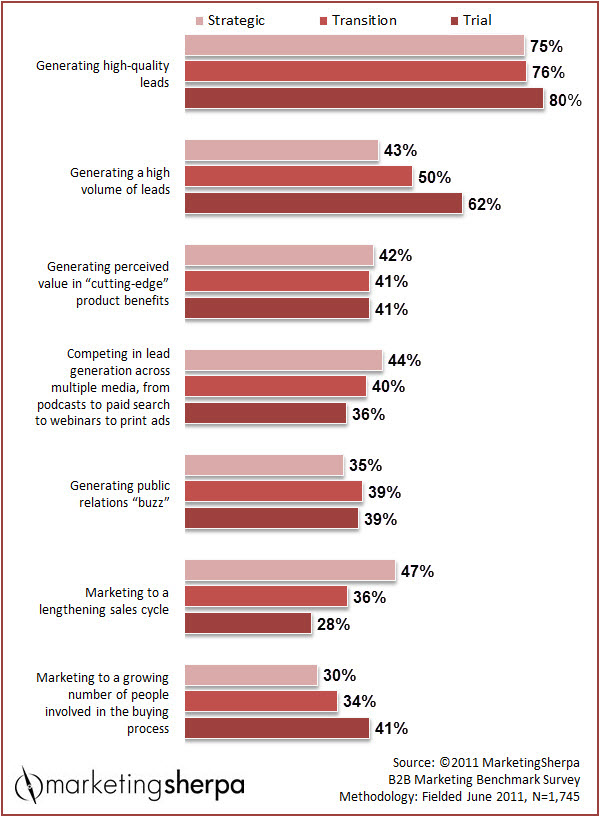
Click here to see a printable version of this chart
To help you understand the chart, in a previous Benchmark Report question, we asked marketers to describe the process their organization uses to plan, execute and measure the performance of lead generation, qualification, scoring, nurturing, hand-off/management and funnel optimization. The choices were:
- Strategic — Formal process, thorough guidelines, routine performance
- Transition — Informal process, few guidelines, sporadic performance
- Trial — No process or guidelines currently
All B2B marketers are challenged by generating high-quality leads
As you can see in the chart, generating high-quality leads is far and away the top challenge identified in the Benchmark Report.
While some challenges varied in importance based on marketing maturity — for example, 62% of trial-phase marketers were challenged by generating a high-volume of leads versus only 43% for strategic marketers; 47% of strategic marketers were challenged by marketing to a lengthening sales cycle, while only 28% of trial-phase marketers responded similarly — the spread was much tighter for this challenge, ranging from 80% of trial-phase marketers to 75% of strategic marketers recognizing this challenge.
So, we all know what the problem is … what is the solution?
Generating high-quality leads is an immensely difficult and complex problem to tackle, illustrated by the range of marketers recognizing this challenge. The ways to address it are equally varied and complicated. I don’t want to belittle the challenges you face every day in your job by touting an easy panacea — even if that tends to make for compelling article headlines that get shared widely across the Web.
My goal with today's Marketing Chart of the Week is to have you walk away and ask this question of yourself and your team …
How well do we perform the lead management blocking and tackling?
Let’s be frank, that's one of the most fun areas of the job and it's maybe even why you became a marketer. You get to forge partnerships, work with agencies on creative, even attend the Super Bowl if your budget and lead generation goals are big enough.
That would be all well and good if your only goal was generating mountains of leads. But, as you can see in the chart, that challenge is secondary to generating high-quality leads, because …
Sales doesn't want leads
Your CEO doesn't want leads, either. Also, your shareholders absolutely do not care about leads.They care about paying customers.
Therefore, contact information from someone who filled out a form, downloaded a white paper, signed up for an email, attended a webinar or fits a certain demographic profile in and of itself has no value.
It takes blocking and tackling. It takes lead management. It takes not just capturing the leads, but qualifying them, nurturing them and delivering them to Sales in an effective manner to create that value.
Yet, elsewhere in the Benchmark Report we found that only 22% of marketers find lead hand-off and management to be a challenge. More marketers see the challenge in pieces of the process like lead nurturing (40%), but less so in connecting all the pieces together that make for a successful process.
Perhaps that's because blocking and tackling isn't as popular as buzz-worthy tactics like social and mobile and QR codes.
Perhaps that's because marketers feel that CRM and marketing automation systems will do all of the work for them.
While these tools can be effective, the hammer is only as good as the carpenter wielding it.
So, let's end on this note. Ask yourself and your team if you are taking your lead management process for granted. Because, as this marketer responded in the Benchmark Report, the challenge will only become more difficult …
"The decision pipelines for higher-end products are becoming narrower and longer with more controls at the corporate level. The slower economy and company resistance to spending not only make budgets tighter but funnel management slower."
Related Resources
B2B Marketing Infographic: How are B2B marketers optimizing their funnel?B2B Marketing: 4 steps a systems integrator took to achieve Marketing-Sales alignment
B2B Marketing: How Cisco transformed its marketing strategy to better serve customers [Video]
CALENDAR
CATEGORIES
TAGS
TWITTER POSTS
CALENDAR
- powered by
- One Big Broadcast
- creative by
- WebStager
© 2025 One Big Broadcast | All rights reserved
